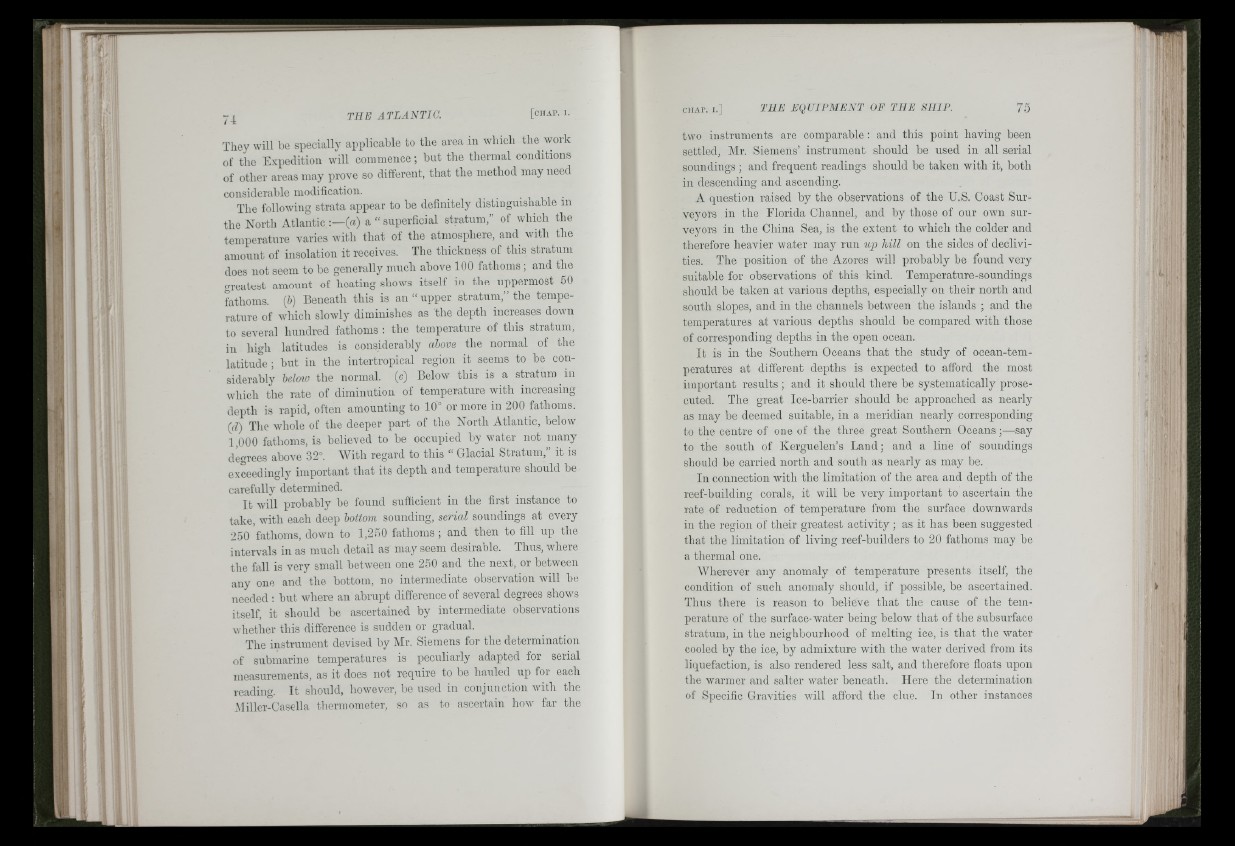
i , li- '
JI .
t
A
I- .
I:
|i1
THE ATLANTIC.
They will be specially applicable to tlie area in wliicli the woik
of tlie Expedition will commence ; but tlie tliermai conditions
of otlier areas may prove so different, that the method may need
considerable modification.
The following strata appear to be definitely distinguishable in
tlie North Atlantic (a) a “ superficial stratum/’ of whioh the
temperature varies with that ot the atniospliere, and with tiie
amount of insolation it receives. The thickness of tins stratum
does not seem to be generally nnicii above 100 fathoms ; and the
greatest amount of heating shows itself in the uppermost 50
fatlioms. (5) Beneath this is an “ upper stratum, the temperature
of which slowly diminishes as the depth increases down
to several liiindred fatlioiiis : the temperature of tiiis stratum,
in liigii latitudes is considerably above tlie normal of tlie
latitude ; but in the iiitertropical region it seems to be considerably
beloiv the normal, (c) Below this is a stratum in
wliich the rate of diminution of temperature with increasing
depth is rapid, often amounting to 10° or more in 200 fathoms.
(d) Tlie whole of tlie deeper part of tiie North Atlantic, below
1,000 fathoms, is believed to he occupied by water not many
degrees above 32°. With regard to tliis “ Glacial Stratum,” it is
exceedingly important tliat its depth and temperature should he
carefully determined.
I t will probably be found sufficient iii the first instance to
take, with each deep bottom sounding, serial soundings at every
250'fathoms, down to 1,250 fathoms; and then to fill up tlie
intervals in as mncli detail as may seem desirable. Thus, where
the fall is very small between one 2o0 and the next, or between
any one and the bottom, no intermediate observation will be
needed : but where an abrupt difference of several degrees shows
itself, it should be ascertained by intermediate observations
whether tiiis difference is sudden or gradual.
The instrument devised by Mr. Siemens for the determination
of submarine temperatures is peculiarly adapted for serial
measurements, as it does not require to be iiaiiied up for each
reading. I t should, however, be used in conjunction with the
Miller-Casella tiiermometer, so as to ascertain how far the
two instruments are comparable : and this point having been
settled, Mr. Siemens’ instrument should be used in all serial
soundings ; and frequent readings should be taken with it, both
in descending and ascending.
A question raised by the observations of the U.S. Coast Surveyors
in the Florida Channel, and hy those of our own surveyors
ill the Cliina Sea, is the extent to which the colder and
tlierefore heavier water may run up hill on the sides of declivities.
The position of the Azores will probably be found very
suitable for observations of this kind. Temperature-soundings
should be taken at various depths, especially on their north and
soutli slopes, and in tlie channels between the islands ; and tlie
temperatures at various depths should be compared with those
of corresponding depths in the open ocean.
It is in the Southern Oceans that the study of ocean-tem-
peratnres at different depths is expected to afford the most
important results ; and it should there be systematically prosecuted.
The great Ice-barrier should be approached as nearly
as may be deemed suitable, in a meridian nearly corresponding
to the centre of one of the three great Southern Oceans ;—say
to the south of Kerguelen’s Land; and a line of soundings
should be carried north and soutii as nearly as may be.
In connection with the limitation of the area and depth of the
reef-building corals, it will be very important to ascertain the
rate of reduction of temperature from the surface downwards
in the region of their greatest activity ; as it has been suggested
that the limitation of living reef-bnilders to 20 fathoms may be
a thermal one.
AVherever any anomaly of temperature presents itself, the
condition of such anomaly should, if possible, he ascertained.
Thus there is reason to believe tbat tlie cause of the temperature
of the surface-water being below that of the subsurface
stratum, in the neighbourhood of melting ice, is that tlie water
cooled by the ice, by admixture with the water derived from its
liquefaction, is also rendered less salt, and therefore floats upon
the warmer and saiter water heneatii. Here the determination
of Specific Gravities will afford the clue, in other instances